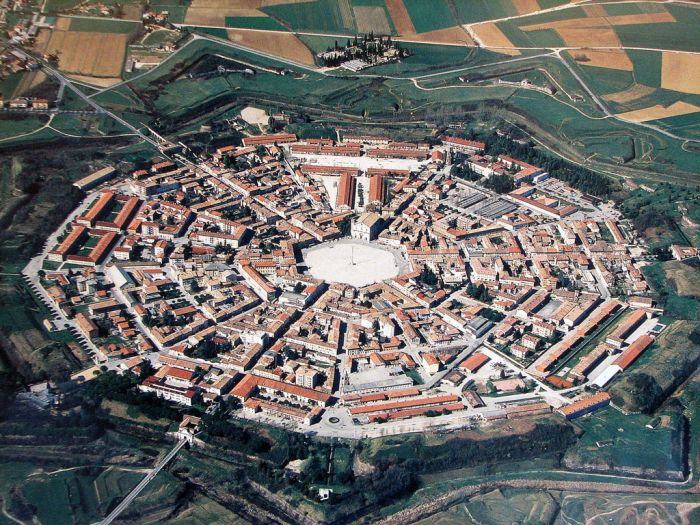|
|
Palmanova, Friuli-Venezia Giulia, Udine, Italy
|
Palmanova is a city in Italy constructed during the renaissance and it is a city built following the ideals of a utopia. It is a concentric city with the form of a star, with three nine sided ring roads intersecting in the main military radiating streets. It was built at the end of the 16th century by the Venetian Republic which was, at the time, a major center of trade. It is actually considered to be a fort, or citadel, because the military architect Giulio Savorgnano designed it to be a Venetian military station on the eastern frontier as protection from the Ottoman Empire.
During the renaissance many ideas of a utopia, both as a society and as a city, surfaced. Utopia was considered to be a place where there was perfection in the whole of its society. This ideas started by Sir Thomas More, when he wrote the book Utopia. The book described the physical features of a city as well as the life of the people who lived in it. His book sparked a flame in literary circles. A great many other books of similar nature were written in short order. They all followed a major theme: equality. Everyone had the same amount of wealth, respect, and life experiences. The society had a calculated elimination of variety and a monotonous environment. The city where they lived was always geometric in shape, and was surrounded by a wall. These walls provided military strength, but also protected the city by preserving and passing on man’s knowledge. The knowledge, learning and science gave form to the daily life of the people living inside the walls. The knowledge of each person was shared by the entire society, and there was no way to let any information either in or out. As Thomas More said in his book, “He that knows one knows them all, they are so alike one another.”
Alberti, followed by Filarete, were the first to develop the ideas of a Utopia into the plan of a city. Filarete designed a concentric city, with peaks and radiating streets, which he called Sforzinda. His geometry was the imitation of a schema representing the work. It is believed to have derived from two overlaying squares. Sforzinda later became the most influential plan in the design of Palmanova. Since Palmanova was built during the renaissance, it imposed geometrical harmony and followed the idea that beauty reinforces the wellness of a society. Each road and move was carefully calibrated and each part of the plan had a reason for being. Each person would have the same amount of responsibility and land, and each person had to serve a specific purpose. The concentric shape was the most prominent design move, and had many reasons for being.
The circular shape of Palmanova was greatly influenced by the fact that it needed to be a fort. At the time of its construction, many other urban theoreticians found the checkerboard was more useful, but it could not provide the protection that military architects desired. The walls of a practical fort are run at angles so that enemy soldiers could not approach it easily because the angles made it possible to establish overlapping fields of fire.
|
|









